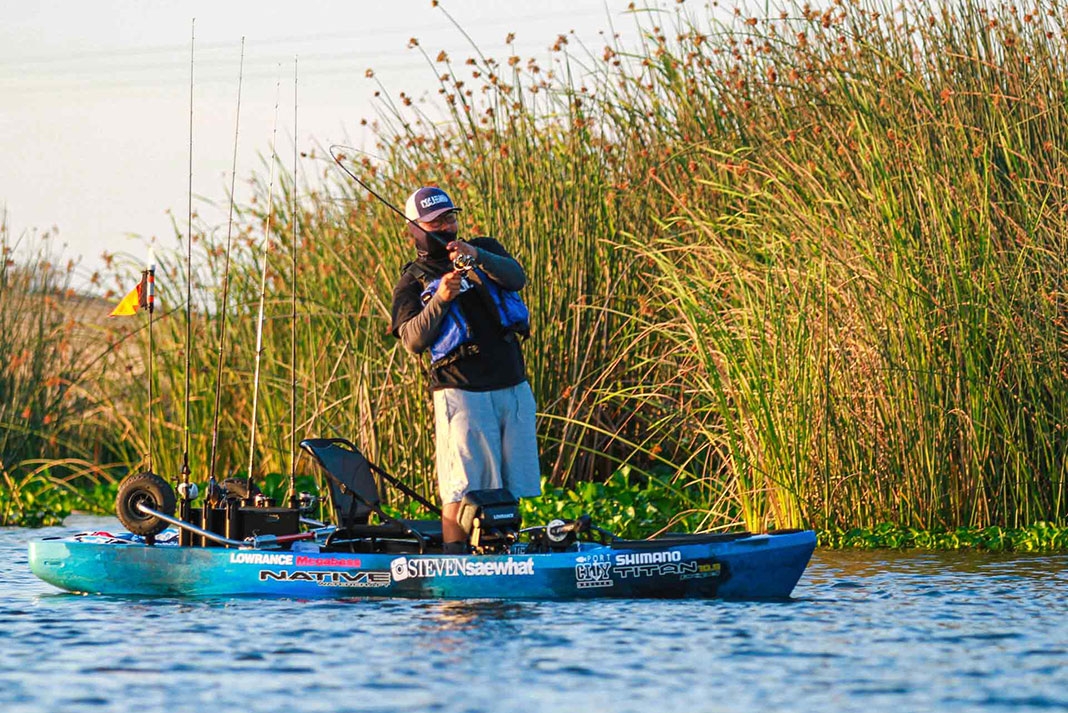California presents a great opportunity to target trophy largemouth and striped bass with oversized lures. The trout stocking program makes this fishery tick. State hatcheries dump thousands of bite-size trout into lakes and reservoirs where largemouth and striped bass are waiting for the easy meal.
The predators grow large and aggressive on this high-protein food source, and anglers dedicated to fishing with 12-inch lures are rewarded with the bass of a lifetime. My brother Sam dialed in his swimbait program for the past seven years resulting in some eye-popping catches. Here are some tips we have discovered.
Super Size: Target Trophy California Bass with Larger Lures
Conditions
The best weather conditions combine low light with broken or windblown points, bluff walls or shallow flats near deep water. The high-percentage areas occur where trout need to swim around an obstacle or the poor little rainbow is trapped in a dead-end ambush point.

For example, when a trout needs to swim around a rock and expose itself to a deep ledge, the bass will pin the little fish to the rock. This is where I try to place my lure.
Another situation traps a trout in a shallow pocket near deeper water. Trout tend to swim circles once they are trapped. This is a perfect place to use a hitched retrieve with a wider S-action in the lure. Use short snaps of the rod tip with slack line to give the lure an ultra-wide, pivoting action.
Tactics
Since the key to catching large bass with a large lure is feeling the slightest tap on the line, I start by anchoring my kayak or holding it in position with my trolling motor. I position the kayak so I can make a long cast landing the lure past the ambush point.
Then, I creep the lure along the depth contour allowing the lure to occasionally bump the bottom. When the lure passes through the ambush zone, I speed up and then slow the retrieve to get the fish’s attention.
Large walk-the-dog style lures like the Lunker Punker get bites when the fish want to eat on top, especially during pre-frontal conditions or at night. Best of all, the Lunker Punker is easy to cast into the wind.
Soft swimbaits do it all. I burn them in fast or fish the lure nearly in place punctuated with short rod-tip twitches. To crawl the lure along the bottom, I slow the retrieve until I feel the lure bouncing into structure.
Jointed hard lures, like the Deps 250, swim side to side. Using a twitch and long pause retrieve causes the lure to shoot to the left and right. Some jointed baits, like the Gancraft Jointed Claw, have an add-on bill that converts it into a wake bait. The wake bait option is great for fishing over grass or among stick-ups.
Fishing from a kayak with a trolling motor and Power-Pole Micro anchor makes it easier to hold the boat in position and work the lure through a very specific zone. A stationary boat also allows me to feel the slightest tap on the line indicating contact with the bottom or a big bass.
Top Baits
Use a lure for its intended purpose such as: depth of water, speed of retrieve, gradual versus steep transitions. The same presentations apply to both largemouth and striped bass.
- 8” Lunker Punker walking bait by Black Dog Bait Co.
- 10” Savage Gear RTF Trout – easy beginner swimbait
- 10” Megabass Magdraft – all-conditions swimbait
- Deps 250 – open water lure with a wide glide
- S-Waver 200 – doesn’t require specialized tackle
Tackle & Gear
- Daiwa DX swimbait rod with a Lexa 300 reel
- 20-lb test monofilament or copolymer line for added stretch and shock absorption
- Power-Pole Micro shallow water anchor
- MotorGuide Xi3 kayak motor
- On the Water Innovations PA 14 bow mount
- Large Frabill Trophy Haul Predator landing net
Kayaks
- Old Town Sportsman AutoPilot 136
- Hobie Pro Angler 14 with Xi3 trolling motor
Weed out the little ones. | Feature photo: Jeffrey Fortuna










Nice – that’s one heck of a fish!